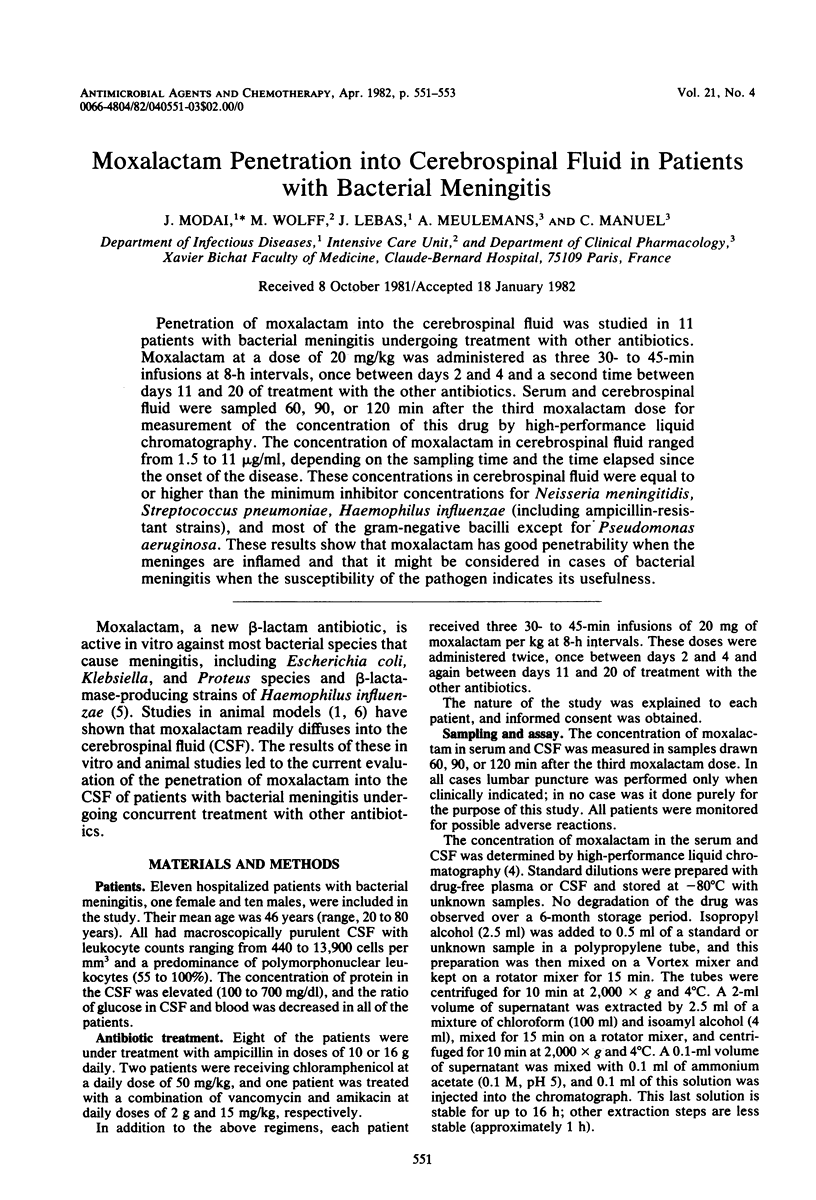Abstract
Penetration of moxalactam into the cerebrospinal fluid was studied in 11 patients with bacterial meningitis undergoing treatment with other antibiotics. Moxalactam at a dose of 20 mg/kg was administered as three 30- to 45- min infusions at 8-h intervals, once between days 2 and 4 and a second time between days 11 and 20 of treatment with the other antibiotics. Serum and cerebrospinal fluid were sampled 60, 90, or 120 min after the third moxalactam dose for measurement of the concentration of this drug by high-performance liquid chromatography. The concentration of moxalactam in cerebrospinal fluid ranged from 1.5 to 11 micrograms/ml, depending on the sampling time and the time elapsed since the onset of the disease. These concentrations in cerebrospinal fluid were equal to or higher than the minimum inhibitor concentrations for Neisseria meningitidis, Streptococcus pneumoniae, Haemophilus influenzae (including ampicillin-resistant strains), and most of the gram-negative bacilli except for Pseudomonas aeruginosa. These results show that moxalactam has good penetrability when the meninges are inflamed and that it might be considered in cases of bacterial meningitis when the susceptibility of the pathogen indicates its usefulness.
Full text
PDF


Selected References
These references are in PubMed. This may not be the complete list of references from this article.
- Cordera C. S., Pekarek R. S. Treatment of experimental Haemophilus influenzae type b meningitis with 1-oxa-beta-lactam (LY127935). Antimicrob Agents Chemother. 1980 Feb;17(2):258–262. doi: 10.1128/aac.17.2.258. [DOI] [PMC free article] [PubMed] [Google Scholar]
- Kaplan S. L., Mason E. O., Jr, Garcia H., Kvernland S. J., Loiselle E. M., Anderson D. C., Mintz A. A., Feigin R. D. Pharmacokinetics and cerebrospinal fluid penetration of moxalactam in children with bacterial meningitis. J Pediatr. 1981 Jan;98(1):152–157. doi: 10.1016/s0022-3476(81)80562-8. [DOI] [PubMed] [Google Scholar]
- Landesman S. H., Corrado M. L., Cherubin C. C., Gombert M., Cleri D. Diffusion of a new beta-lactam (LY 127935) into cerebrospinal fluid. Implications for therapy of gram-negative bacillary meningitis. Am J Med. 1980 Jul;69(1):92–98. doi: 10.1016/0002-9343(80)90505-7. [DOI] [PubMed] [Google Scholar]
- Miner D. J., Coleman D. L., Shepherd A. M., Hardin T. C. Determination of moxalactam in human body fluids by liquid chromatographic and microbiological methods. Antimicrob Agents Chemother. 1981 Aug;20(2):252–257. doi: 10.1128/aac.20.2.252. [DOI] [PMC free article] [PubMed] [Google Scholar]
- Neu H. C., Aswapokee N., Fu K. P., Aswapokee P. Antibacterial activity of a new 1-oxa cephalosporin compared with that of other beta-lactam compounds. Antimicrob Agents Chemother. 1979 Aug;16(2):141–149. doi: 10.1128/aac.16.2.141. [DOI] [PMC free article] [PubMed] [Google Scholar]
- Schaad U. B., McCracken G. H., Jr, Loock C. A., Thomas M. L. Pharmacokinetics and bacteriological efficacy of moxalactam (LY127935), netilmicin, and ampicillin in experimental gram-negative enteric bacillary meningitis. Antimicrob Agents Chemother. 1980 Mar;17(3):406–411. doi: 10.1128/aac.17.3.406. [DOI] [PMC free article] [PubMed] [Google Scholar]
- Schaad U. B., McCracken G. H., Jr, Threlkeld N., Thomas M. L. Clinical evaluation of a new broad-spectrum oxa-beta-lactam antibiotic, moxalactam, in neonates and infants. J Pediatr. 1981 Jan;98(1):129–136. doi: 10.1016/s0022-3476(81)80559-8. [DOI] [PubMed] [Google Scholar]


